SLICES





Here’s the thing about being a writer in a deadline-oriented job: Sometimes your deadlines and your brain don’t see eye to eye. Words don’t always travel from the cortex to the fingertips and finally to the computer screen as quickly as I’d like. (Hello, writer’s block!)
Sometimes I waste precious time staring out the window waiting for inspiration to hit. Then, confident that I’ve discovered my “a-ha” moment, start expounding on a train of thought that ultimately leads nowhere. Too often, I don’t realize my ideas are hitting a dead end until I read over my carefully wordsmithed paragraphs with fresh eyes the next day and end up nixing all of them. Thank goodness for the clarity new days bring!
But when words do flow freely, there’s nothing like a well-turned phrase and a point that can be made succinctly and cleverly thanks to an ample vocabulary and a mind that is usually editing what I write before I press the keys. I enjoy the writing process immensely when that happens.
I am sometimes asked where I find ideas to write about. The answer: Anywhere and everywhere. Sometimes I read articles that enlighten or amuse me, and I can’t help but comment on the content. I might have some thoughts about an event occurring that month or things happening in my life that you might relate to. Often, I wonder if I should amp up the adventure in my life to give me more fodder for my columns. That thought is actually kind of funny: shouldn’t living life more fully be enough of a goal itself? Why am I more concerned about writing about it?
That’s easy to answer. I’ll do whatever it takes to create topics to avoid writer’s block. Well, anything within reason!
Three ways to contact us: To send us recipes, photos, event listings, letters and entries for gift drawings, please use the forms on our website indianaconnection.org; email info@indianaconnection.org; or send to Indiana Connection, 8888 Keystone Crossing, Suite 1600, Indianapolis, I
VOLUME 72 • NUMBER 5 ISSN 0745-4651 • USPS 262-340
Published monthly by Indiana Electric Cooperatives
Indiana Connection is for and about members of Indiana’s locally-owned, not-for-profit electric cooperatives. It helps consumers use electricity safely and efficiently; understand energy issues; connect with their co-op; and celebrate life in Indiana. Over 304,000 residents and businesses receive the magazine as part of their electric co-op membership. Member’s cost per issue is approximately 32 cents, plus postage.
CONTACT US: 8888 Keystone Crossing, Suite 1600 Indianapolis, IN 46240-4606 317-487-2220 info@indianaconnection.org IndianaConnection.org
INDIANA ELECTRIC COOPERATIVES OFFICERS: Randy Kleaving President
Steve McMichael Vice President
Dr. Richard Leeper Secretary/Treasurer
Tom VanParis Interim CEO
EDITORIAL STAFF: Emily Schilling Editor

Richard George Biever Senior Editor
Holly Huffman Communication Support Specialist

Lauren Carman Communication Manager
Kiley Lipps Graphic Designer
Amber Knight Creative Manager
Mandy Barth Vice President of Communication
ADVERTISING: American MainStreet Publications
Cheryl Solomon, local ad representative; 512-441-5200; amp.coop
Crosshair Media 502-216-8537; crosshairmedia.net
Paid advertisements are not endorsements by any electric cooperative or this publication.
UNSOLICITED MATERIAL: Indiana Connection does not use unsolicited freelance manuscripts or photographs and assumes no responsibility for the safe keeping or return of unsolicited material.
SUBSCRIPTIONS: $12 for individuals not subscribing through participating REMCs/RECs.

CHANGE OF ADDRESS:
If you receive Indiana Connection through your electric co-op membership, report address changes to
POSTAGE: Periodicals postage paid at Indianapolis,
and
POSTMASTER: Send change of address to: Indiana Connection, 8888 Keystone Crossing, Suite 1600, Indianapolis, IN 46240-4606. Include key number.
No

of Indiana Connection may be
without permission of the editor.
of

Andrew Zink,
means his dad’s
pie. And so,
Winona Lake student shared a slice with us all in his 11th grade entry in the




of Student Art
The work not only won his grade division but also won Best of Show.
A favorite holiday tradition for many of us is baking cookies, pies, cakes and other sweet goodies to share with family and friends. To help ensure that your time in the kitchen is fun and fruitful, follow these holiday baking tips.


Before you start baking, organize and prep your work area. Make sure you have plenty of room — especially if you plan to make several pies, cakes or batches of cookies. Start by clearing off your counters, getting any clutter out of the way. Then wipe them down. Now, get all your tools (measuring cups and spoons, bowls, cookie cutters, etc.) out and in plain view. Better to do it now instead of scrambling to find something in the middle of mixing the ingredients.
them with parchment paper or non-stick silicon baking mats first. Or, for Bundt cakes, be sure to coat the pan with melted butter or oil and sifted allpurpose flour first.
Make a list of the recipes you plan to make, noting all the ingredients you’ll need and how much. Then translate that into packaging terms.
Example:
• 7 cups of butter = 14 sticks. Buy 4 packages.
• 6 cups of sugar = 3 pounds. Buy a 5-pound bag.
• 12 cups of flour. Each cup is about 4.5 ounces so 12 cups is 54 ounces. That is about 3.4 pounds. Buy a 5-pound bag.
Check your pantry to see if you already have any ingredients you’ll need. If you do, make sure that the ingredient is not expired. If it is, throw it out and replace it.
Planning a holiday baking marathon? Then you’ll probably need some extra cooling racks. Your ironing board can come to the rescue. Remove the cover and voila! You have a super-sized cooling rack that you can set up in a convenient location in the kitchen.
It’s best to use room temperature eggs when baking since they will more easily incorporate into batter. If you forget to take them out of the fridge to give then ample time to rest, just place them in a bowl of warm water for about 10 minutes.
Butter should also be at room temperature. Take it out of the fridge 1-2 hours before mixing your ingredients together. Cut the butter into cubes to speed up the warming up process.
To ensure your baked goods can easily be removed from baking pans and sheets, line
Turn baking day into a divideand-conquer party. Assign different tasks to family and friends. For instance, one person can cut the cookie dough into shapes, another can place the cookies onto baking sheets and put them in and take them out of the oven, someone else can place the cookies on a cooling rack, another can frost them, and someone else can oversee the sprinkles. Oh, and everyone is on tastetesting duty!
If you can’t enlist others to help you bake, manage your expectations. Don’t overload yourself. Pick one to three treats that you want to make and tackle those. Now isn’t the time to try something new. Bake what you’ve already mastered.
Bake when you have time and put the sweet treats in the freezer until they’re ready to be enjoyed. Even iced and decorative sugar cookies can be frozen.
chocolate and sprinkle with chopped walnuts. Or, frost the cookies with royal icing and add fancy flourishes to your heart’s content.
One cookie dough can make a variety of cookies. For example, after rolling and cutting out sugar cookies, top with sprinkles before baking. Bake others plain and, after baking, dip them halfway into melted
When making molded cookies, chill cookie dough overnight or at least a couple of hours before forming the balls and baking them. The dough will be less sticky and easier to work with, plus, more importantly, it keeps the cookies from spreading too much. With most recipes, you can even make the dough ahead of time, freeze it, and then take it out and let it come to room temperature before baking.
Use powdered sugar instead of flour when rolling out sugar cookies. The powdered sugar will add sweetness to the cookies, and you won't have to worry about adding too much flour.
Cookies will burn less easily if they are baked on a light silver cookie sheet rather than a dark colored sheet.
Use a small plastic bag to cover your hand when greasing the baking sheet. Place your covered hand in the bag, then scoop out some shortening and spread it on the baking sheet. When finished, remove the bag and throw it away.

If the outer edges of the cookies are getting browned and their centers are not completely cooked, reduce the temperature 15 to 25 degrees. Your cooking time will increase slightly. Increasing the baking temperature would only brown the outer edges faster and the center of the cookie would still be under baked.
Allow cookie sheets to cool in between batches to keep cookie dough from melting and becoming too thin at the edges.
When it’s time to bake the cookies, place them on the top rack of the oven. If baking two sheets of cookies at one time, place them on different racks at different angles to allow proper air circulation. Switch racks about halfway through the cooking time. When baking cookie bars, place the baking pan in the middle rack of the oven.
For an easy decoration, add a few chocolate chips, white chocolate chips or M&Ms on top of the cookies just after you’ve removed them from the oven so that they’ll sit on top without being melted into the dough.
Cool the cookies completely before storing or packaging them in airtight containers. Otherwise, the cookies will get soggy from the condensation that will develop.
For soft cookies that have started to dry out, re-soften by adding a piece of bread or a slice of apple to the container they are stored in.
For crispy cookies that have started to get soggy, make them crispy again by placing them on a cookie sheet and heating in the oven at 300 F for 3 or 4 minutes.
them and place them on a cooling rack to cool completely. If you leave them in the pan, they may continue to bake just from the heat of the pan, and you could end up with cupcakes that are drier than you wanted.
If your frosting is thicker than you’d like it to be, add in milk a little at a time until it reaches the consistency you’re looking for.
No pastry bag for frosting? Use a heavyduty plastic zipper lock bag with the corner snipped off instead.
If you don’t have enough batter to fill a full muffin tin, fill the remaining empty cups with a little water – this will help the rest of the cupcakes bake more evenly.
After you’ve removed the cupcakes from the oven, only leave them in the pan for a couple minutes and then carefully remove
To fill a pastry bag with frosting, fit the tip in the bag and then set it inside a pint glass and fold the top of the bag over the sides of the glass. This will make it much easier to spoon in your frosting.
When piping frosting onto cupcakes, there is a right way to do it!
• Hold the pastry bag with one hand firmly holding the twisted end and your other hand near the bottom.
• Hold the bag straight up and down while
you move in a circle (either from the outside in, or the inside out depending on the look you’re going for) and once you’re done gently release pressure as you pull the bag up. This will give the cupcake a nice clean peak.
ingredients. Ingredients used to make the pie crust, such as butter and water, should be used while cold. For a golden brown, flaky pie crust, use a lightweight oldfashioned aluminum pie tin.
No need to buy fancy pie weights. Line your unbaked pie shell with foil and fill with dried beans or rice.
Prepare the pie dough the night before and chill overnight in the refrigerator. Roll the dough and bake the next day.
Roll out the dough between two sheets of parchment paper. That way, you’ll just need a sprinkle of flour between the dough and the parchment but not much.
Allow ingredients for the pie filling, such as eggs, butter, and milk, to become room temperature before mixing with other
When making a double crust pie, moisten the edge of the bottom crust with water before placing the second crust on top. The moistened edge will help create a good seal once the two crusts are crimped together. Then, for a beautiful presentation, brush the top crust with water and sprinkle with sugar before sliding the pie in the oven to bake.
Prevent the edges of your pie from becoming too brown by covering the edge with foil after the first 15 minutes of baking.

From solar power systems to electric vehicles, you may have noticed an increase in how often batteries and electric storage are discussed. Some homeowners may consider adding battery systems as a home backup power source.
Adding a home battery system is a major investment: possibly more than $10,000, and even higher if you install a large system. Before you sign a battery system purchase contract, there are a few things you should consider.
This is the first question your electric co-op’s energy advisor will ask. If you are concerned that your home is losing power frequently, co-op employees can research the issue and come up with potential fixes, which may save you from spending any money.
If you plan to charge the battery at night and then use it during peak demand or sell it back to your co-op,
the math may not yet add up. Timeof-use rates offered by some co-ops can help make the batteries more affordable. Yet the large upfront cost of most battery systems can lead to longer paybacks (and there is no guarantee they will break even). Understanding your needs will help your contractor find the battery system best suited for you.
It’s important to consider not only the battery system’s storage capacity, but also its discharge rate (how much power in terms of watts the battery discharges into your home). Storage capacity is not the discharge rate! You need to understand prior to purchase what your battery system will do and not be surprised after it is installed. Your co-op’s energy advisor can provide insight on the energy needed to power certain appliances and systems.
Once you know the battery system you want, seek multiple bids from different contractors. It’s important to understand what each contractor is offering. Question each salesman’s assumptions. Does he or she know your cost of electricity? Will a contractor provide a walkthrough on set up or support after installation? A good contractor should be willing to answer questions even after service is completed.
By knowing the right questions and considerations, you can be sure that the battery system you purchase will meet your needs. Your electric co-op’s energy advisor is always available to answer questions about energy storage and your home’s energy use. Be sure to contact your co-op before you sign a contract to make sure that the dollars make sense!
 by Joe Spear Energy Advisor
Carroll White REMC
by Joe Spear Energy Advisor
Carroll White REMC

317-487-2220.
of Headquarters or General Business Office of Publisher: Indiana Electric Cooperatives, 8888 Keystone Crossing, Suite 1600, Indianapolis, Marion County, IN 46240-4606. 9. Full Names and Complete Mailing Address of Publisher, Editor, and Managing Editor: Publisher: Indiana Electric Cooperatives, 8888 Keystone Crossing, Suite 1600, Indianapolis, Marion County, IN 46240-4606. Editor: Emily Schilling, Indiana Electric Cooperatives, 8888 Keystone Crossing, Suite 1600, Indianapolis, Marion County, IN 46240-4606. Managing Editor: None. 10. Owner: Indiana Electric Cooperatives, 8888 Keystone Crossing, Suite 1600, Indianapolis, IN 46240-4606. 11. Known Bondholders, Mortgagees, and Other Security Holders Owning or Holding 1 Percent or More of Total Amount of Bonds, Mortgages, or Other Securities: None. 12. Tax Status (For completion by nonprofit organizations authorized to mail at nonprofit rates). The purpose, function, and nonprofit status of this organization and the exempt status for federal income tax purposes has not changed during preceding 12 months. 13. Publication Title: Indiana Connection. 14. Issue Date for Circulation Data Below: Oct. 2022. 15. Extent and Nature of Circulation: Electric co-op members in Indiana. a. Total Number of Copies (Net press run): Average No. Copies Each Issue During Preceding 12 Months: 310,134. No. Copies of Single Issue Published Nearest to Filing Date: 311,148. b. Paid Circulation (By Mail and Outside the Mail). (1) Mailed Outside-County Paid Subscriptions Stated on PS Form 3541 (Include paid distribution above nominal rate, advertiser’s proof copies and exchange copies): Average No. Copies Each Issue During Preceding 12 Months: 308,896. No. Copies of Single Issue Published Nearest to Filing Date: 310,010. (2) Mailed In-County Paid Subscriptions Stated on PS Form 3541 (Include paid distribution above nominal rate, advertiser’s proof copies and exchange copies): Average No. Copies Each Issue During Preceding 12 Months: 0. No. Copies of Single Issue Published Nearest to Filing Date: 0. (3) Paid Distribution Outside the Mails including Sales Through Dealers and Carriers, Street Vendors, Counter Sales, and Other Paid Distribution Outside USPS: Average No. Copies Each Issue During Preceding 12 Months: 0. No. Copies of Single Issue Published Nearest to Filing Date: 0. (4) Paid Distribution by Other Classes of Mail Through the USPS (e.g. First-Class Mail): Average No. Copies Each Issue During Preceding 12 Months: 0. No. Copies of Single Issue Published Nearest to Filing Date: 0. c. Total Paid Distribution ((Sum of 15b (1), (2), (3), and (4)): Average No. Copies Each Issue During Preceding 12 Months: 308,896. No. Copies of Single Issue Published Nearest to Filing Date: 310,010. d. Free or Nominal Rate Distribution (By Mail and Outside the Mail). (1) Free or Nominal Rate Outside-County Copies included on PS Form 3541: Average No. Copies Each Issue During Preceding 12 Months: 273. No. Copies of Single Issue Published Nearest to Filing Date: 158. (2) Free or Nominal Rate Copies In-County Copies Included on PS Form 3541: Average No. Copies Each Issue During Preceding 12 Months: 0. No. Copies of Single Issue Published Nearest to Filing Date: 0. (3) Free or Nominal Rate Copies Mailed at Other Classes Through the USPS (e.g. First-Class Mail): Average No. Copies Each Issue During Preceding 12 Months: 0. No. Copies of Single Issue Published Nearest to Filing Date: 0. (4) Free or Nominal Rate Distribution Outside the Mail (Carriers or other means): Average No. Copies Each Issue During Preceding 12 Months: 0. No. Copies of Single Issue Published Nearest to Filing Date: 0. e. Total Free or Nominal Rate Distribution (Sum of 15d (1), (2), (3) and (4): Average No. Copies of Each Issue During Preceding 12 Months: 273. No. Copies of Single issue Published Nearest to Filing Date: 158. f. Total Distribution (Sum of 15c and 15e): Average No. Copies Each Issue During Preceding 12 Months: 309,169. No. Copies of Single Issue Published Nearest to Filing Date: 310,168. g. Copies not Distributed (See Instructions to Publishers #4 (page #3): Average No. Copies Each Issue During Preceding 12 Months: 965. No. Copies of Single Issue Published Nearest to Filing Date: 980. h. Total (Sum of 15f and g): Average No. Copies Each Issue During Preceding 12 Months: 310,134. No. Copies of Single Issue Published Nearest to Filing Date: 311,148. i. Percent Paid (15c divided by 15f times 100): Average No. Copies Each Issue During Preceding
• Bartholomew County REMC
• Boone REMC
• Carroll White REMC
• Clark County REMC
• Daviess-Martin County REMC
• Decatur County REMC
• Dubois REC
• Fulton County REMC
• Harrison REMC
• Heartland REMC
• Hendricks Power Cooperative
• Henry County REMC
• Jasper County REMC
• Jay County REMC
• JCREMC
• Kankakee Valley REMC
• Kosciusko REMC
• LaGrange County REMC
• Marshall County REMC
• Miami-Cass REMC
• Newton County REMC
• Noble REMC
• Northeastern REMC
• Orange County REMC
• Southeastern Indiana REMC
• Steuben County REMC
• Whitewater Valley REMC
• WIN Energy REMC
Newton County REMC and Southeastern Indiana REMC have inserted calendars in this issue of Indiana Connection. Copies are also available through the mail from Indiana Connection.

Daviess County might be named for a Kentuckian, but it’s embraced, produced, perpetuated, and exported one of Indiana’s greatest crops: basketball — including bushel baskets of ballplayers.
Washington High School ranks third in the list of most Indiana High School boys basketball state championships. It has seven, one behind Marion and Muncie Central, who are tied with eight.
Washington’s first three came in 1930, 1941 and 1942, long before the advent of the IHSAA class tourney. The last four came as 3A champs, led by the legendary Zeller boys: Luke, Tyler, and Cody.
None of the Zellers were born in Daviess County (they moved to Washington in 1993 when the oldest, Luke, was 6), but they soon owned its hardwood and brought back the hardware. From 2001 to 2011, they led Washington High School to four state championships — 2005, 2008, 2010, and 2011. Luke’s one championship in 2005 came with his legendary lastsecond, midcourt, game-winning shot in overtime.
All three brothers were named Indiana Mr. Basketball their senior year and a McDonald’s All-American. Luke graduated from Washington in 2005; Tyler graduated in 2008; and Cody in 2011. After high school, all three received scholarships at storied college basketball programs — Notre Dame, North Carolina, and Indiana, respectively. All three played, at least briefly, in the NBA.
But before the Zeller trio came, there was Robert David “Big Dave” DeJernett. Born appropriately on George Washington’s birthday in 1912 in Kentucky, the future Washington
Hatchet star came to Daviess County soon after. A member of the Indiana Basketball Hall of Fame, DeJernett is remembered for integrating the Washington Hatchets and leading them to their first Indiana state title as a junior in the 1929–30 season. The Hatchets were the first integrated high school basketball state champions in U.S. history.
As a 6-foot-3, 230-pound sophomore, DeJernett was put on the varsity squad in 1928 and was named to the All-State team after the Hatchets lost in the 1929 state finals.
In the 1930 championship game, DeJernett led Washington over the Muncie Central Bearcats 32–21. Muncie was also led by a Black player, Jack Mann, who stood 6-foot-6 but could not outjump DeJernett which contributed largely to the victory. The Hatchets finished with a 31-1 record that year.
As a senior, DeJernett’s Hatchets were favored to win a second state crown in the spring of 1931. Prior to an important regional match up, DeJernett received a threatening letter from the Ku Klux Klan that hinted if he played he’d meet the same fate as the two young Black men who had been lynched in Marion, Indiana, the previous summer. DeJernett not only played, he scored 14 points to lead Washington’s 22–19 victory. In the quarter finals of the state tourney, however, Muncie Central avenged their previous year’s loss to Washington, eliminating Washington 21-19 on the way to their second state championship.
Two weeks later, Notre Dame’s legendary football coach Knute
Rockne was a featured speaker at a banquet of unity honoring both the Hatchets and the Washington Catholic Cardinals, winners of the 1931 Catholic Boys’ State Championship. Afterward, Rockne shook hands with members of each team. DeJernett thought Rockne might not want to shake hands with a Black man and passed by him. Rockne grabbed DeJernett by the hand and shook it. Two days later, Rockne died in a plane crash in Kansas.
In his three years on the team, DeJernett led Washington to a 75-17 record and was named All-State three times. He also became the state’s first dominant Black collegiate player. From 1931 to 1935 DeJernett played for the integrated Indiana Central College team, now known as the University of Indianapolis Greyhounds. The 1934 Greyhounds went 16–1 and posted the state’s top collegiate record. As a pro, DeJernett played for barnstorming teams, including the Harlem Globetrotters. He died suddenly of a heart attack in Indianapolis in 1964.


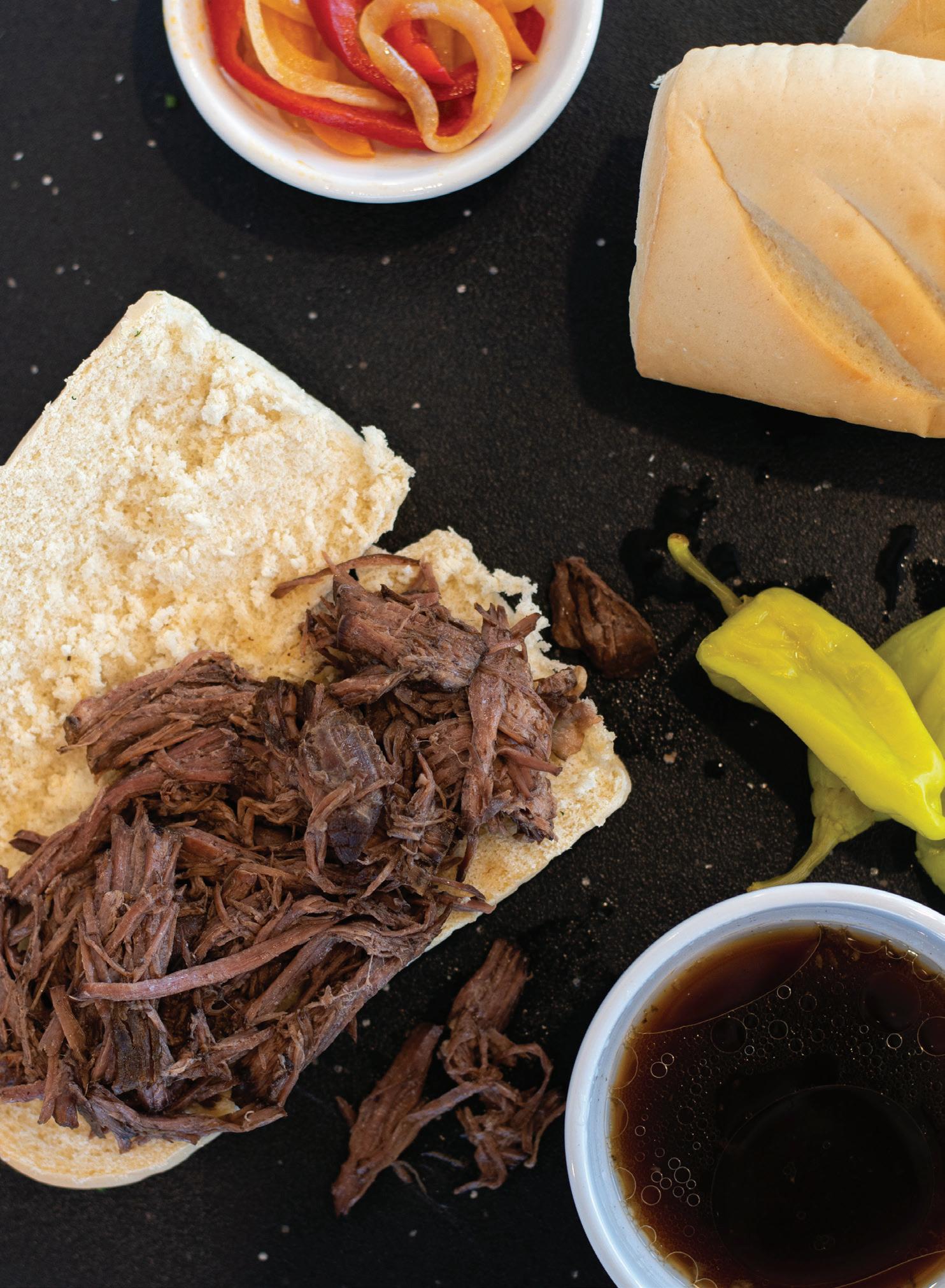
Amelia Patrie, West Lafayette,
•
•
•
Cook’s note: Any leftovers can
basis
• 4 boneless, skinless chicken breasts
• 2 (10.75 oz.) cans cream of chicken soup
• 2 (0.87 oz.) envelopes chicken gravy mix
• ¼ cup Worcestershire sauce
• 1 (4 oz.) can sliced mushrooms
Place chicken in a slow cooker. Mix chicken soup with gravy mix and Worcestershire sauce. Pour mixture over chicken. Cook on Low for 6-8 hours. Break chicken into bite-sized pieces before serving.
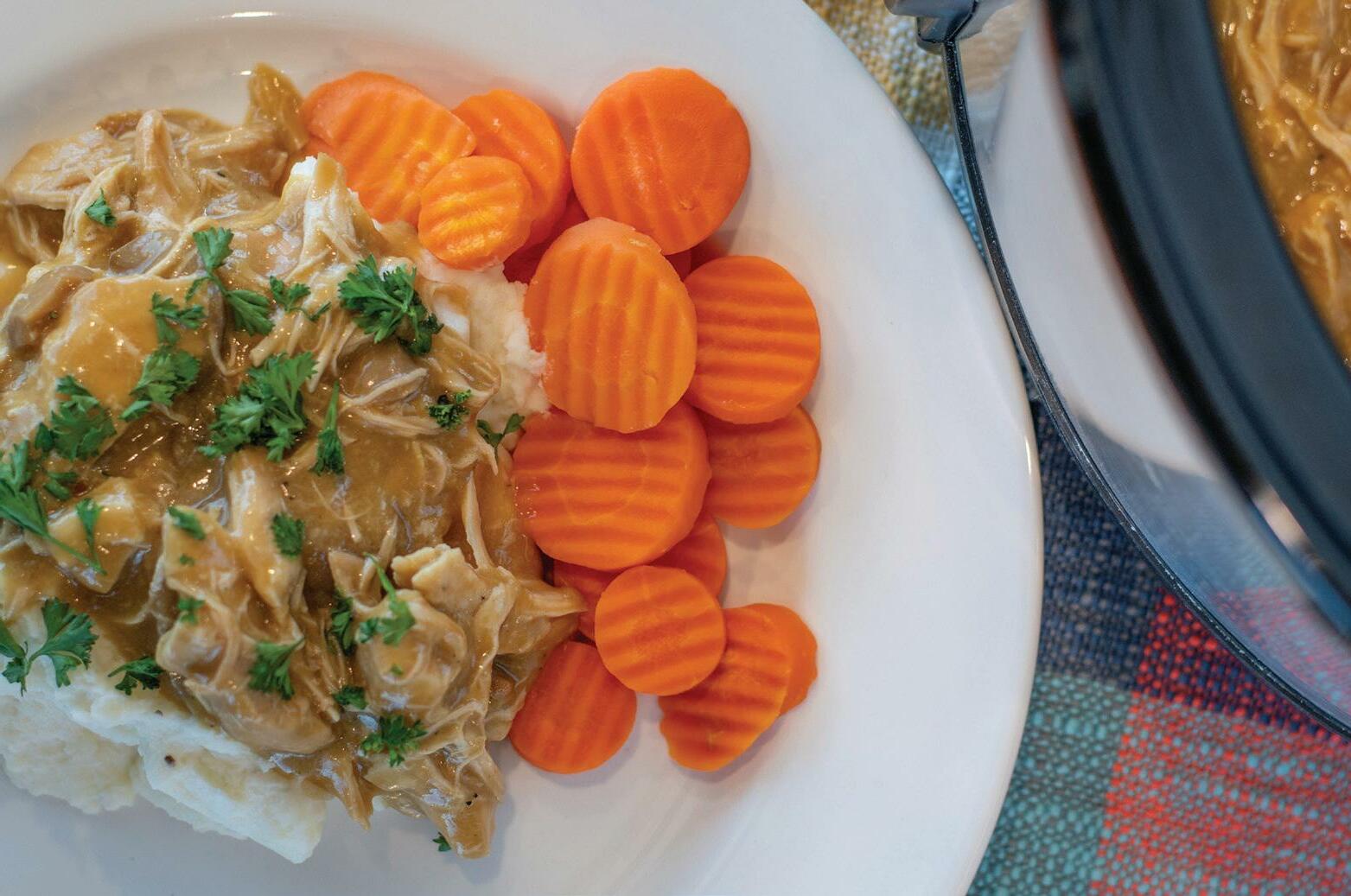

Cook’s note: Don’t make the gravy. You only need the dry mix. The broth from the chicken will do the rest. Feel free to substitute chicken thighs or tenderloins in place of the chicken breasts. Add mixed vegetables if desired.
• 3-4 lbs. beef arm pot roast
•
t. vegetable oil
•
t. salt
•
⁄
•
t. pepper
t. ginger
•
whole cloves
•
medium apples, cored and quartered
Wipe roast well and trim off all the excess fat. Lightly rub top of meat with oil. Dust with salt, pepper and ginger. Insert cloves in roast. Place apples and onions in slow cooker and top with roast (cut roast in half, if necessary, to fit easily). Pour in apple juice. Cover and cook on Low setting for 8 to 12 hours.
•
small onion, chopped
•
cup apple juice or water
• 3-4 T. flour
•
T. water
Remove roast and apples to warm platter. Turn slow cooker to High setting. Make a smooth paste of the flour and water; stir into slow cooker. Cover and cook until thickened.
Nancy Moore, Kendallville, Indiana
MEAN OL’ DADDY’S CHICKEN AND GRAVY Joe Squier, Corydon, Indiana


It’s 300 months. It’s the “Silver Anniversary.” It’s a quarter of a century, and, for the average American, it’s a third of a lifetime. Come January, it’s also the amount of time editions of the Cooperative Calendar of Student Art have been adorning walls of electric consumers all over Indiana.
The 2023 calendar — the 25th edition — is now printed and available at participating electric co-ops. (Please see page 11 for distribution details.)
The calendar is illustrated with the artwork of Indiana students in grades kindergarten through high school senior. These are the winning works from the art contest Indiana’s electric cooperatives held last spring.


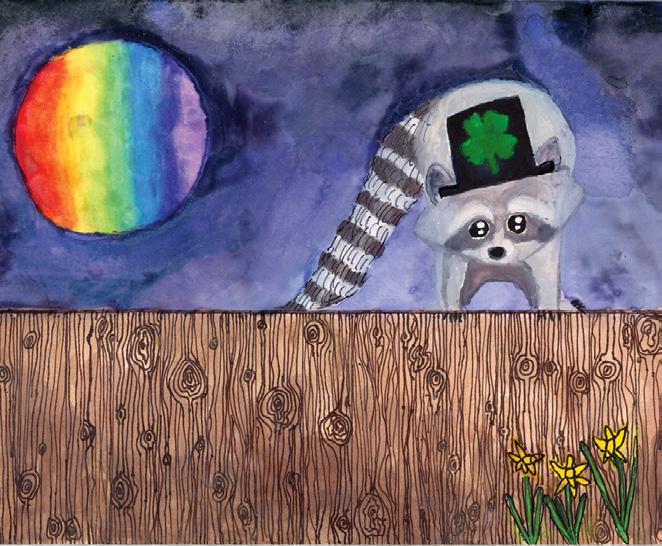
The first contest was held in the fall of 1998. Those winning works illustrated the 1999 Cooperative Calendar. For all but one edition since, the calendar has followed a simple formula. Since there are 12 grades in school and 12 months in a year, first graders are asked to illustrate January; second graders are assigned February; and so on through 12th graders who are assigned December.
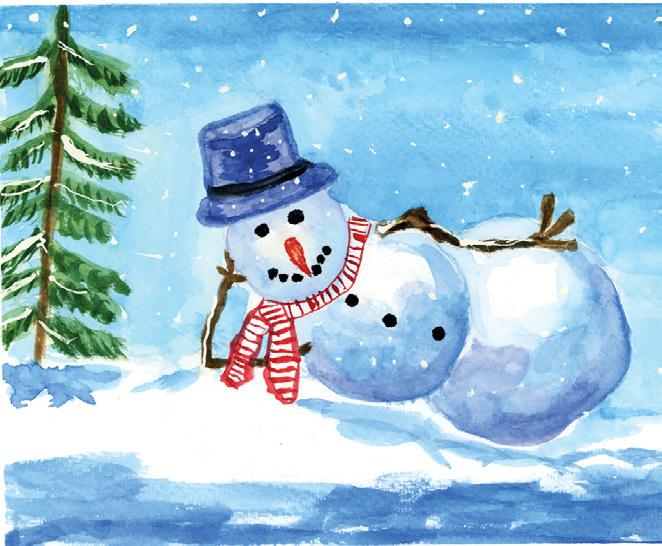
Like all calendars, the student art calendar represents a transition of time through a single year. But
through the imagination and talent of the students themselves, each turn of the calendar page depicts their transition from childhood to junior high to adulthood. Kindergartners were given the cover to illustrate to welcome each year and open the contest up to all 13 grades.
“We’re proud to have encouraged tens of thousands of young artists to craft such beautiful masterpieces throughout these last 25 years of the calendar art project,” said Emily Schilling, editor of Indiana Connection. “And, by having their artwork reproduced in a wall calendar, we’ve been able to share their talents with so many Hoosiers around the state.”
Schilling and Senior Editor Richard Biever came up with the art contest/ calendar concept early in 1998 to celebrate student artists. In addition, the calendar became a much-anticipated holiday gift and informational piece consumers received from participating REMCs/ RECs. Indiana Connection staff has been coordinating the project for participating co-ops ever since.
“The calendar is a great way to bring art into homes, and inspire other kids to pick up crayons, pencils and paint brushes and create magic,” Schilling added.
FLYNN CISSELL Borden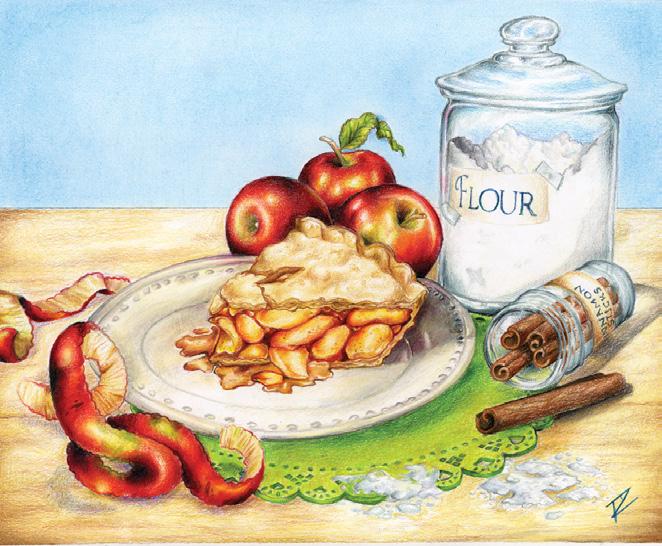
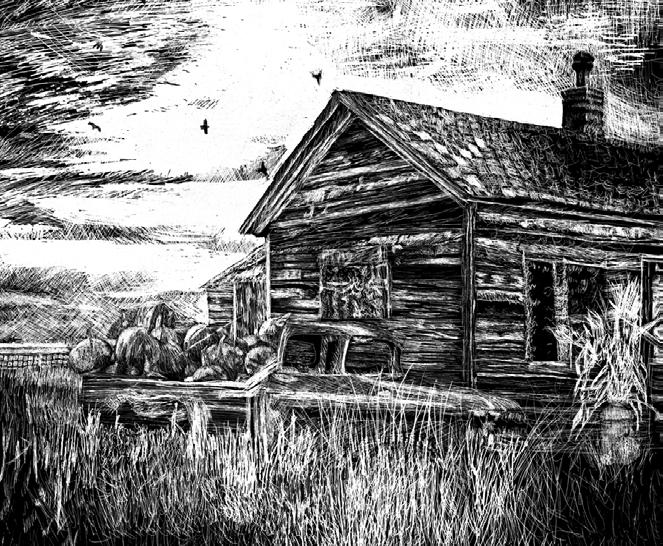

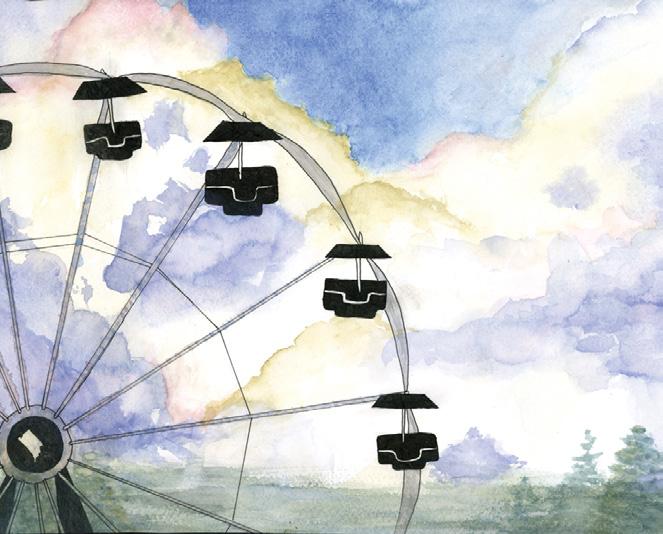




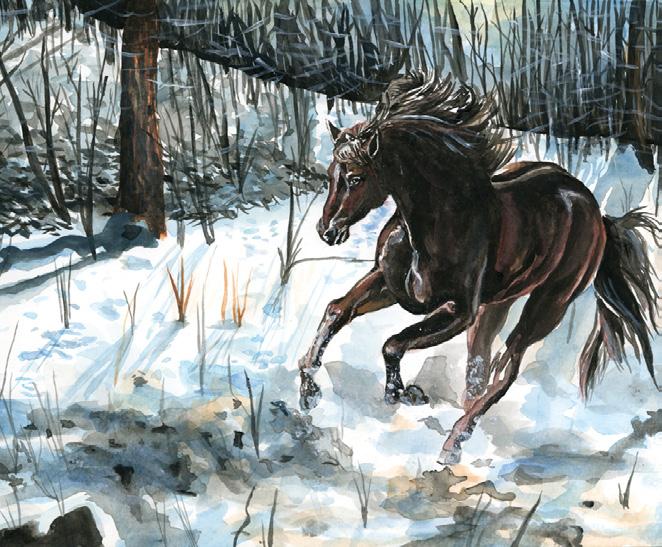
of Student Art contest was selected the “Best of Show.”
Andrew Zink is a student illustrator successfully touching subject matter about as allencompassing as the initials of his first and last name.
Landscape? His work as an eighth grader of a backyard bonfire beside a lake on a starry night graced the August page of the 2020 Cooperative Calendar of Student Art.

Figures? His illustration as a 10th grader of a young boy carving a pumpkin illustrated the October page of the 2022 Cooperative Calendar.
Still life? His apple pie on a plate will grace the November page of the 2023 Cooperative Calendar. And the work, which won the 11th grade division in last spring’s Cooperative Calendar

“Since it was for November,” says Andrew, “our family does this thing with apple pies. It's just the smell that always reminds me of November. It's a tradition that stemmed from my mom and dad.”
More than tradition, it’s how his dad won his mom over.
“Before we started dating,” explains his mom, Kristy, “my husband called me up kind of out of the blue. We didn't really know each other, we just had mutual friends, and I was sicker than a dog with a cold.
The next day, he dropped off a homemade apple pie he made himself with his grandma's recipe.
“So, he makes apple pies every Thanksgiving. We go up and pick apples in Michigan a lot. Most of the fall is apple pies, ‘apple this’ and ‘apple that.’”
For the artwork, Andrew assembled the objects for the still life … gathered apples and peeled one, cinnamon sticks, canister of flour, plate. But for the scrumptious-looking slice of pie, Andrew admits it’s not his own or even his dad’s. Having created the artwork late last winter for the mid-March deadline, he opted for a frozen apple pie from ALDI that he baked. He then composed and shot as a reference photo of it all
to create the illustration. He rendered the work primarily in colored pencil. Though obviously the pie couldn’t have tasted like his dad’s, he says it was still pretty good. One of the benefits of photographing the pie was it was still edible when he was done. The work not only earned him $200 for his third first-place win in the contest, but $100 extra for being Best of Show.
In addition, the work will become the still life he was still needing as part of the portfolio he plans to submit for his college entrance.
“Since I didn't have a still life, I thought this would be a good subject,” he says.
Andrew turns 18 later this month. The homeeducated Winona Lake senior plans to attend
Lipscomb University in Nashville, Tennessee, where he wants to study gaming animation. Lipscomb is a private Christian liberal arts college with a nationally recognized animation program.
He had attended public and private Christian schools up through his sophomore year, the last being Lakeland Christian Academy in Winona Lake. He and his parents decided to homeschool his junior and senior years to have the time to concentrate on building a portfolio in hopes of being accepted into Lipscomb’s art program.
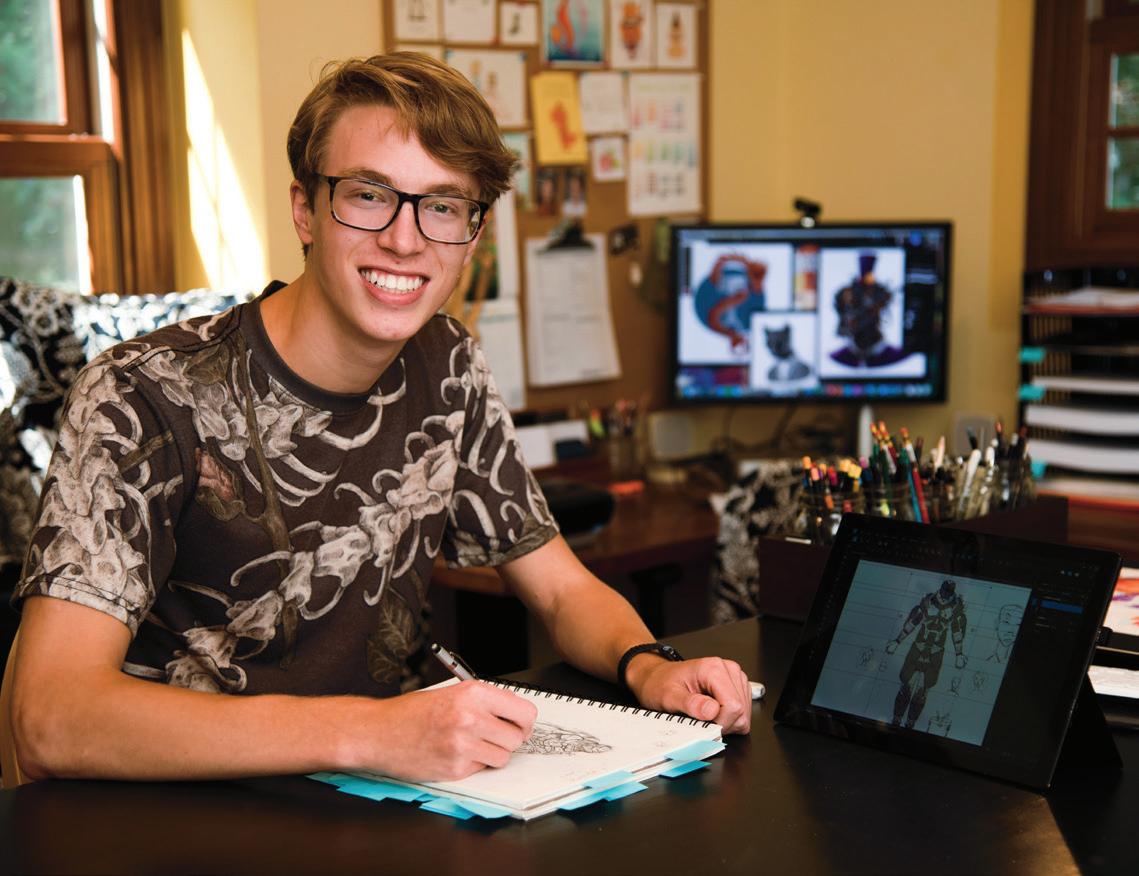
He plans to focus on the gaming side, not the film side, of computer animation.
“I really like designing characters and armor and sci-fi sort of stuff.”
Andrew says he started thinking seriously about art as a career in eighth grade, the year he first won his grade division in the Cooperative Calendar of Student Art contest. He credits his art teacher, Jorie Bail, at Lakeland for encouraging him to pursue his artistic talents.
His mom says the artsy roots for both Andrew and his sister started when they were young. His sister, Emmaline, three years his senior, is already studying art at Lipscomb. She won an honorable mention in 2021’s calendar art contest as a high school senior.
“They've been drawing since I could throw the crayons down on the floor and say, ‘Stay busy, I've got something to do,’” she says. “They have just been surrounded by it their entire life.”
Andrew draws from both his parents for his artistic inspiration, and not just subject matter. His mom’s a freehand artist and graphic designer who loves illustrating people while his dad is a mechanical engineer who works with computer design in the high-tech
world of orthopedic medical devices of which Warsaw is the center.
His mom credits Legos Andrew loved when he was younger to help him see in three-dimensions and translate perspective to paper. An offshoot of Legos in the early 2000s, Bionicles, gave him his first tastes of the science-fiction fantasy and computer animation he now loves. His love of computer gaming furthered that interest.
“He can do very technical drawings,” she says. “So, he gets that technical part and being able to see in three dimensions from his dad.”
Andrew enjoys entering the Cooperative Calendar Art Contest, he says, because it’s statewide.
“It's such a bigger thing than just a local contest. I get to display my art to the entire state.” Plus, he notes he can’t lie: the big cash prize is a nice incentive, too.
“I always strive to make something different, or just be creative,” he says. “I've been always wanting to create stuff that's nonexistent. I like to create.”
“It’s a God-given talent to create,” says his mom, “so use it, use it.”
Richard G. Biever is senior editor of Indiana Connection
Rachel Linnemeier (then Rachel Crisp) won her grade division as a junior in the 2007 calendar and a senior in 2008’s. Her work as a junior was also named 2007’s “Best of Show.”
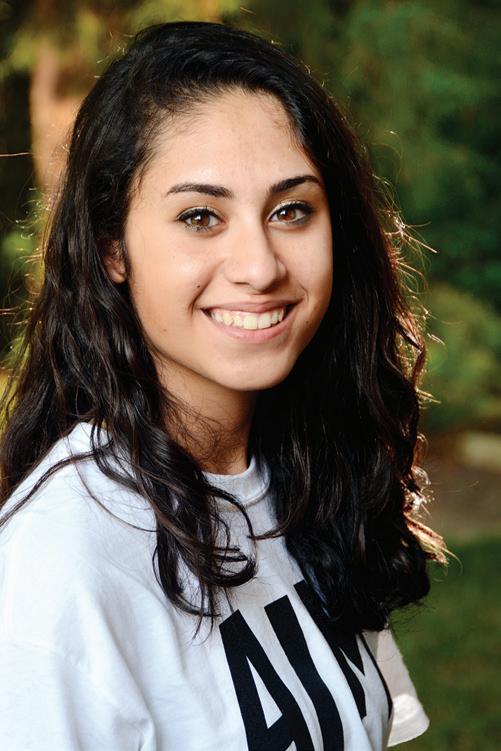
After high school, the Adams Central High School graduate earned a Bachelor of Fine Arts degree in painting from Indiana University’s Herron School of Art and Design in Indianapolis. She soon began carving out a niche in Indy’s art circles with a series of paintings that created visual plays on words.

She has since moved to Tucson, Arizona, and is still painting. She has had works accepted into exhibitions in many locations including Barcelona and Dublin. From January to March 2023, a selfportrait of hers will be included in an exhibition at the 33 Contemporary Gallery in Chicago.
During the COVID shutdown of many in-person gallery events, she began writing and illustrating a children’s book focused on desert animal facts. She hopes to self-publish it within the next year or two.
Readers might remember the portrait of baseball legend Hank Aaron in an Indianapolis Clowns Negro Leagues uniform on the cover of the April 2022 issue.

That was painted by Athena Silot, another past winning student artist. Athena was four-time grade division winner, 8th through 11th, appearing in 2013-16 calendars. After graduating from Avon High School, Athena earned a Bachelor of Fine Arts degree in studio art from Illinois State University in Normal, Illinois.
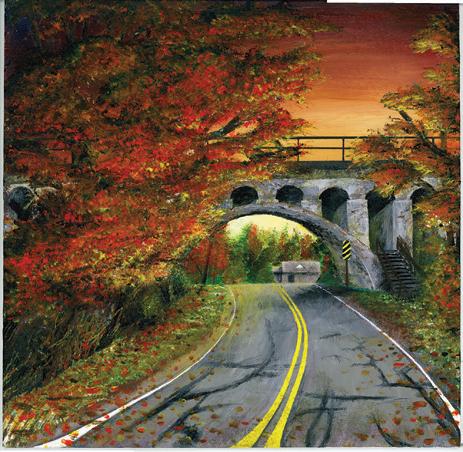
She has begun setting up an art studio in a new home outside Peoria, Illinois, where she plans to pursue commissioned and freelance work, and continue painting for exhibitions and for fun.
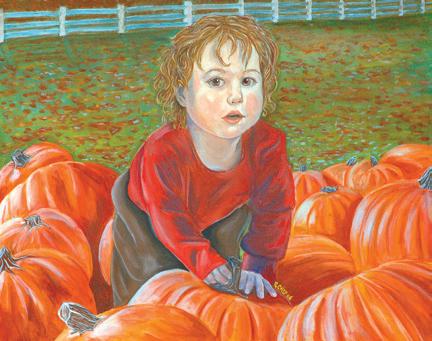
Q:Does the length of the sweet potato vine affect the yield? I have some 6 feet long. Should these be cut back to about 3 feet?
— Allan McKinley, BordenA:Cutting back sweet potato vines is not generally recommended. Healthy vigorous vines generally should improve yield. Although overabundance of nitrogen can promote foliage growth at the expense of root formation, this should not be a problem if you have appropriate balanced nutrient availability in the soil.

More information on growing and harvesting sweet potatoes can be found at purdue.edu/hla/sites/yardandgarden/ time-to-harvest-sweet-potatoes/
Longtime Indiana Connection contributer B. Rosie Lerner, a Tipmont REMC consumer, is a retired Purdue Extension consumer horticulturist. Questions about gardening issues may be sent to “Ask Rosie,” Indiana Connection, 8888 Keystone Crossing, Suite 1600, Indianapolis, IN 46240-4606, or use the form at IndianaConnection.org.

Q:Help! We really like rhubarb, however, mine has not fared well the last couple years. It is not producing much, and the stalks are thin and spindly. It is in a raised bed and has a soaker hose. I always use the leaves from cuttings as mulch. It is 22 years old and has always been good until recently. Do I fertilize or what? It has full sun.
— Gen Dornbush, AvillaA:Sounds like your rhubarb could benefit from dividing to rejuvenate the planting. You can dig and lift the plants in early spring before the new growth starts. Divide the crowns so that each section has three-four buds. Reset the divisions so that the buds are only about 2 inches deep.
Find more information at hort.purdue.edu/ hort/ext/Pubs/HO/HO_097.pdf

Power the avid campers in your life with energy-efficient gifts this holiday season.
The falling autumn leaves will soon give way to falling snowflakes and carolers singing our way into the holiday season. While it may seem like an odd time to plan outdoor getaways, it’s the right time for gifts that will help avid campers get ahead! Technology has led to some unique possibilities offering comfort (and electricity) in far-flung locations for those on your gift list this year.
A great idea that offers versatility! A variety of portable batteries are available to enable campers to charge devices such as cell phones, laptops and other small electronics. Companies such as Jackery offer portable batteries and solar panels that can be combined so the battery can be charged when not in use.
Batteries and solar panels with larger
capacity carry a larger price tag. Yet if you’re shopping for an avid outdoor enthusiast, the larger storage capacity (which allows for use of more devices) may be a worthwhile investment.
SOLAR LANTERN OR RECHARGEABLE FLASHLIGHT: The evolution of solar power means that a variety of devices can be charged. Energy-efficient lanterns and flashlights incorporate LEDs, which are more energy efficient and emit brighter light than older generation flashlights. Solar lanterns are rechargeable when exposed to sunlight. Other kinds of rechargeable flashlights can be plugged into a wall outlet or portable battery and recharge to provide invaluable illumination on dark nights.
The Electrify Indiana 2022 conference was held Sept. 22 in Indianapolis. It was co-hosted by Hoosier Energy and Wabash Valley Power Alliance along with the Beneficial Electrification League.
What got the over 270 attendees, 33 sponsors and 23 exhibitors buzzing was the interaction.
With utilities, businesses and industry leaders all gathered under the same roof, the opportunities for such interaction were almost endless. Most of all, the discussions were highly productive.
“Face to face is still good, not just a Zoom or Teams meeting,” said Norm Campbell, an Electrify Indiana panelist and federal team manager for Go Electric, headquartered in Anderson.
“The information and the crosstalk were excellent. I made several good connections that I think are going to be very fruitful in the big picture, not just from a business perspective but helping move solutions in the right direction.
INDUCTION COOKTOP: This device provides a unique alternative to campfire cooking. A portable induction stovetop can be taken to a campsite as an energyefficient way to heat food in a pan. It will need an electrical power source (maybe a larger battery such as a Jackery system), to ensure that the watt requirements of the induction cooktop can be met by the portable battery. Yet for someone who wants to pack different kinds of food to a campsite, an induction cooktop may be the way to go.
New portable electronic devices and appliances are regularly hitting the market, offering new possibilities for campers to enjoy. Learn more about new electronics that can leave your gift recipients beaming this holiday season.
“In my opinion, you need to have utilities engaged and involved because it’s their distribution system that gets impacted even if you work behind the meter,” Campbell continued. “There’s a lot of mutual benefit to having customers and utilities understand what each other can do.”
The vendors on hand, ranging from California-based Camus Energy and Enel X Way to familiar national brands like Milwaukee, Altec and Generac to the homegrown three-person staff of Hoosiers For Renewables, helped facilitate even more understanding.
“It’s been interesting to hear the perspective from the vendor side,” said Tom Castle of East Kentucky Power Cooperative. “For example, the guys from Rheem talked about how 70 percent of product recommendations come from the contractor. That actually makes sense and makes me wonder if we should work more with the contractors rather than pushing (products) ourselves.”
Communication went both ways, as the vendors also benefited.
“There’s a different feel with those bigger shows, just standing at a booth all day,” said Bianca Jimenez of Enel X Way. “Here you get to know people and interact more.”
Added Steven Brisley of Camus Energy: “It feels more like a family reunion than a trade show.”
It was a reunion that sent everyone home with optimism for the future.
“The connectivity between utilities, end users, policy makers and people that are in the business space was great,” Campbell said. “… (Electrify Indiana) brought a connectivity to some of us in the industry we didn’t have before. I’m looking forward to reaching out and offering some of our ideas to make (improvements) even better and faster.”
Ionce asked an audience what group was responsible for the initial reintroduction of the Eastern Wild Turkey to Indiana. The answers ranged from the “National Wild Turkey Federation” to the “U.S. Fish & Wildlife Service” to the “Audubon Society” and even “The Boy Scouts.” No one came up with the right answer — the United States Navy. The Navy? Yes, the United States Navy!
Around 1956, the new commander of the Crane Naval Ammunition Depot (now Naval Support Activity Crane) in Martin County was disappointed to learn the military base’s rich habitat didn’t include wild turkeys.
Wild turkeys had disappeared from Indiana by the early 1900s because of lost habitat and uncontrolled hunting. The commander enjoyed hunting wild turkey in southern parts of the United States and greatly missed the sport.

As all who served know, the military is capable of many things. And the higher the rank, the greater the possibilities!
Shumaker Naval Depot in Arkansas was contacted and given a “top secret” assignment. Shortly thereafter, the commander of Crane and a handpicked support team met one of the super cargo carrier aircraft on the aircraft runway to unload two mysterious tarp covered boxes.
The two boxes were cages containing five wild turkeys — four hens and a tom. The birds were quickly ushered off to a secluded location on the base and released.
Chances of survival for the tiny flock were slim. If anything happened to the lone male bird, it was over. But by the grace of God, good habitat, control from poaching, and isolation from tame turkeys, the flock rapidly expanded. By the winter of 1960-61, there were an estimated 100 to 200 wild turkeys on the Indiana Naval base.
Beginning in the winter of 1960, attempts to trap enough turkeys on the base and begin spreading them to other parts of the state, namely Brown County State Park, were proving ineffective. At the time, Indiana had an unbelievable population of ruffed grouse, and the biologists’ ability to capture grouse was far better than their turkey attempts.
In 1964, Indiana struck a deal with Missouri. Indiana traded 70 ruffed grouse for 21 Missouri turkeys. The turkeys were released in the Tell City district of the Hoosier National Forest. The following year, 15 turkeys were swapped for 60 grouse and released in the HarrisonCrawford State Forest.
Within a few years, turkeys trapped in Perry and Harrison counties were being released in Martin County and
the Pike and Jackson-Washington state forests.
History was made in 1970 when 60 hunters from 1,500 applicants participated in the first modern-day Indiana sanctioned wild turkey hunt. Over the four-day hunt, most of the hunters heard or saw wild turkeys, while six got their gobblers.
The estimated number of hunters afield this past spring was 65,254 who spent $32 per license. There was an estimated success rate of 19%. The statewide flock is now estimated to be about 120,000 birds.
Not a bad return on a “Special Ops Assignment” by the U.S. Navy and some savvy bartering with kin states to the south and west!
is a syndicated state outdoors writer and a member of RushShelby Energy.
Readers can contact the author by writing to this publication, or by email to jackspaulding@hughes. net. Spaulding’s books, “The Best Of Spaulding Outdoors” and “The Coon Hunter And The Kid,” are available from Amazon.com as paperbacks or Kindle downloads.

Keep your family safe during these joyful times by learning some basic holiday food preparation safety tips before you start cooking.
During the holidays, family and friends gather to celebrate. Usually, food is involved. But not all feasts turn out festive. The United States Fire Administration estimates more than 2,000 residential fires are reported each Thanksgiving, with cooking the leading cause.

“The holidays are supposed to be a wonderful time for families to be together in celebration,” said Jon Elkins, vice president of safety, training and compliance at Indiana Electric Cooperatives. “We just want them to take precautions and be safe.”
Protect your home and family from fire hazards by installing smoke alarms in every bedroom, outside each sleeping area, and on every level of the home. Test the batteries in each smoke alarm every month and replace them once a year. Creating an escape plan for the whole family will ensure that no matter the circumstances, everyone knows how to exit safely.
Unattended cooking equipment is the leading cause of home cooking fires; always be sure someone takes over the preparation when needed. Before cooking, clean the stovetop and oven to wipe away any grease or dust to prevent a fire.
While cooking, it’s easy to forget about something in the oven, especially when you’re entertaining guests. Use a kitchen timer to make sure your dish doesn’t burn to a crisp, creating a fire hazard. When cooking on the stove, protect you and any reaching hands from spills or burns by using the back burners. If children are in the room, keep a close eye on them, or guide them out of the kitchen. If cooking over a hot stove, wear short or closefitting sleeves to avoid a fire. Always locate appliances away from the sink to avoid any electrical dangers. Plug countertop appliances into Ground Fault Circuit Interrupter (GFCI)-protected outlets and keep cords away from hot surfaces like toasters. When finished with these appliances, always unplug them to save energy and avoid electrical hazards.
Before your family can sit down and enjoy the meal you just prepared, be sure all appliances have been turned off. Then you can all enjoy each other’s company during the holiday season with peace of mind knowing everyone is safe.
Are any appliances plugged into extension cords on a permanent basis?
If the answer is “yes,” have a licensed electrician install new outlets where needed or move equipment closer to an outlet. Extension cords are for temporary use and can become a fire hazard.
Are all appliance cords placed so they will not come in contact with hot surfaces?
If you answered “no,” move cords away from all heat sources to avoid them melting or burning from the excess heat.
Is any cord cracked, frayed or otherwise damaged?
If you answered “yes,” do not used damaged cords, especially if there are exposed wires. Have a licensed electrician replace the cord or replace the equipment.

